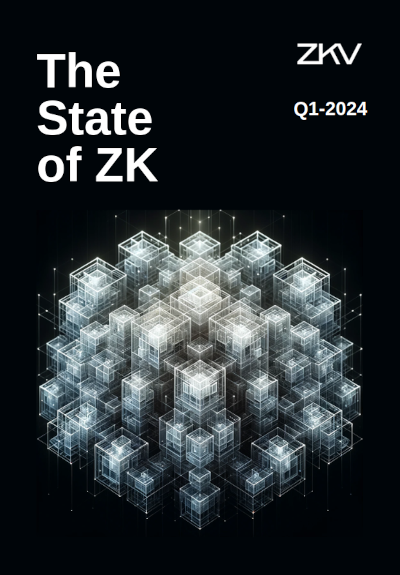Introduction
Welcome to the forefront of innovation in the world of Zero-Knowledge (ZK) technology! The Q1 2024 State of ZK Report is a testament to the rapid evolution and groundbreaking advancements within the ZK ecosystem.
In this comprehensive blog post, we will dissect the key elements of the report, shedding light on the latest developments, emerging trends, and transformative initiatives that are shaping the future of ZK technology.
ZK in Numbers
A quantitative analysis of the impact and adoption of Zero-Knowledge (ZK) technology within the blockchain ecosystem can be shown. Key metrics and statistics related to ZK rollups are a great ally, offering insights into the growth, scalability, and market adoption of ZK solutions.

The Total Value Locked (TVL), which serves as a key indicator of the economic activity and value transacted through ZK-based solutions, reveals that ZK rollups have captured a significant portion of the TVL across Layer 2 (L2) networks, with a total TVL of $3.73 billion as of March 15th. This figure represents approximately 10% of the total TVL across the L2 ecosystem, underscoring the increasing adoption and utilization of ZK rollup technology.
Another metric is the scaling factor that measures the efficiency and impact of ZK rollups in settling transactions on the Ethereum mainnet. The report indicates that ZK rollups have achieved a scaling factor of 3.56x, demonstrating their ability to significantly enhance the transaction throughput and scalability of the Ethereum network.
In terms of specific ZK rollup projects, the chapter highlights the leading solutions in terms of TVL, with Starknet, zkSync Era, Linea, Polygon zkEVM, and Scroll emerging as key players in the ZK rollup space. These projects have demonstrated substantial growth and adoption, further solidifying the position of ZK rollups as a critical component of the blockchain ecosystem.
Emerging Segments in ZK
The emergence of new segments in the ZK ecosystem, such as ZK Prover Marketplaces, zkVMs, and Fully Homomorphic Encryption (FHE) projects, underscores the diverse applications and potential of ZK technology.
The proliferation of ZK prover marketplaces, including Nebra and Succinct’s Prover Network, signifies a growing trend towards decentralizing ZK proof generation. Additionally, the launch of Succinct Processor 1 (SP1) as a new zkVM capable of verifying arbitrary Rust programs showcases the expanding capabilities of ZK systems.
ZK Rollups, a Year Later
The evolution of ZK rollups over the past year has been remarkable, with the number of live ZK rollups increasing to 11 according to L2Beat. These rollups have collectively captured a substantial Total Value Locked (TVL), demonstrating their growing market adoption and scalability. Starknet leads the race in TVL, followed by zkSync Era, Linea, Polygon zkEVM, and Scroll, highlighting the diverse landscape of ZK rollup solutions and their impact on Ethereum’s transaction throughput.
Innovations in ZK Technology
Innovative projects and initiatives showcased in the report, such as Remainder, DOOM in a zkVM, ZK in Bitcoin, STARKPack, and Aggregated Blockchains, exemplify the diverse applications and use cases of ZK technology.
From AI inference in Remainder to running DOOM on a zkVM, these projects demonstrate the versatility and robustness of ZK systems in handling complex operations and enhancing scalability across blockchain networks.
ZK Research
Huge progress has been made in optimizing SNARK/STARK systems, with the introduction of new protocols such as STIR and the Circle STARKs work. These advancements represent a significant step forward in enhancing the efficiency, scalability, and security of ZK systems, paving the way for broader adoption and application across various industries.
Ongoing research efforts and collaborations are aiming at advancing ZK technology, including projects focused on privacy-preserving computation, secure multiparty computation, and homomorphic encryption. These research initiatives are instrumental in pushing the boundaries of ZK technology and exploring new use cases and applications that leverage the power of zero-knowledge proofs.
Decun Upgrade and ZK Impacts
Additionally, the deployment of EIP 4844 as part of Ethereum’s Mainnet Dencun upgrade, has played a crucial role in reducing gas fees on Layer 2 (L2) solutions. This upgrade has had a profound impact on the cost-effectiveness and transaction throughput of ZK rollups, making them more attractive and competitive in the blockchain ecosystem.
ZK Initiatives
One of the central themes is the emergence of new ZK prover marketplaces, such as Nebra and Succinct’s Prover Network, which are aimed at decentralizing ZK proof generation and expanding access to ZK technology. These marketplaces play a crucial role in fostering collaboration, standardization, and accessibility within the ZK community, enabling developers and organizations to leverage ZK proofs for a wide range of applications.
A note of merit even for the Succinct Processor 1 (SP1), a new zero-knowledge virtual machine (zkVM) that can verify arbitrary Rust programs. SP1 represents a significant advancement in ZK technology, offering enhanced performance and flexibility for executing and verifying complex computations securely and efficiently.
We have to take into account he growing interest and involvement of Layer 1 (L1) blockchain networks, such as Celestia, in exploring the integration of ZK technology into their platforms. This trend signifies a broader adoption of ZK solutions beyond Layer 2 (L2) networks, indicating the expanding use cases and applications of ZK technology across the blockchain ecosystem.
Conclusion
In conclusion, the Q1 2024 State of ZK Report paints a vivid picture of the dynamic and rapidly evolving landscape of ZK technology.
From advancements in SNARK/STARK systems optimization to the proliferation of ZK rollups and innovative projects in the ZK space, the report showcases the immense potential and transformative power of ZK technology.
As we look towards the future, it is clear that ZK technology will continue to drive innovation, scalability, and privacy across blockchain networks, ushering in a new era of decentralized applications and secure digital ecosystems.

Leave a Reply